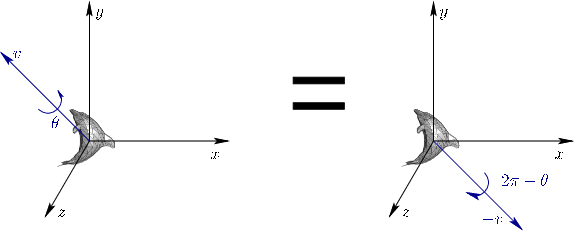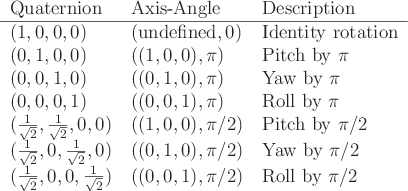
Next: 3.4 Viewing Transformations Up: 3.3 Axis-Angle Representations of Previous: Kinematic singularities Contents Index
 |
Before getting to quaternions, it is important point out one annoying problem with Euler's rotation theorem. As shown in Figure 3.10, it does not claim that the axis-angle representation is unique. In fact, for every 3D rotation other than the identity, there are exactly two representations. This is due to the fact that the axis could ``point'' in either direction. We could insist that the axis always point in one direction, such as positive ![]() , but this does not fully solve the problem because of the boundary cases (horizontal axes). Quaternions, which are coming next, nicely handle all problems with 3D rotations except this one, which is unavoidable.
, but this does not fully solve the problem because of the boundary cases (horizontal axes). Quaternions, which are coming next, nicely handle all problems with 3D rotations except this one, which is unavoidable.
Quaternions were introduced in 1843 by William Rowan Hamilton. When seeing them the first time, most people have difficulty understanding their peculiar algebra. Therefore, we will instead focus on precisely which quaternions correspond to which rotations. After that, we will introduce some limited quaternion algebra. The algebra is much less important for developing VR systems, unless you want to implement your own 3D rotation library. The correspondence between quaternions and 3D rotations, however, is crucial.
A quaternion ![]() is a 4D vector:
is a 4D vector:
| (3.29) |
Let
![]() be an axis-angle representation of a 3D rotation, as depicted in Figure 3.9. Let this be represented by the following quaternion:
be an axis-angle representation of a 3D rotation, as depicted in Figure 3.9. Let this be represented by the following quaternion:
 |
You now have the mappings
![]() and
and
![]() . To test your understanding, Figure 3.11 shows some simple examples, which commonly occur in practice. Furthermore, Figure 3.12 shows some simple relationships between quaternions and their corresponding rotations. The horizontal arrows indicate that
. To test your understanding, Figure 3.11 shows some simple examples, which commonly occur in practice. Furthermore, Figure 3.12 shows some simple relationships between quaternions and their corresponding rotations. The horizontal arrows indicate that ![]() and
and ![]() represent the same rotation. This is true because of the double representation issue shown in Figure 3.10. Applying (3.30) to both cases establishes their equivalence. The vertical arrows correspond to inverse rotations. These hold because reversing the direction of the axis causes the rotation to be reversed (rotation by
represent the same rotation. This is true because of the double representation issue shown in Figure 3.10. Applying (3.30) to both cases establishes their equivalence. The vertical arrows correspond to inverse rotations. These hold because reversing the direction of the axis causes the rotation to be reversed (rotation by ![]() becomes rotation by
becomes rotation by
![]() ).
).
How do we apply the quaternion
![]() to rotate the model? One way is to use the following conversion into a 3D rotation matrix:
to rotate the model? One way is to use the following conversion into a 3D rotation matrix:
Here is a way to rotate the point ![]() using the rotation represented by
using the rotation represented by ![]() . Let
. Let
![]() , which is done to give the point the same dimensions as a quaternion. Perhaps surprisingly, the point is rotated by applying quaternion multiplication as
, which is done to give the point the same dimensions as a quaternion. Perhaps surprisingly, the point is rotated by applying quaternion multiplication as
Here is a simple example for the point ![]() . Let
. Let
![]() and consider executing a yaw rotation by
and consider executing a yaw rotation by ![]() . According to Figure 3.11, the corresponding quaternion is
. According to Figure 3.11, the corresponding quaternion is
![]() . The inverse is
. The inverse is
![]() . After tediously applying (3.33) to calculate (3.34), the result is
. After tediously applying (3.33) to calculate (3.34), the result is
![]() . Thus, the rotated point is
. Thus, the rotated point is ![]() , which is a correct yaw by
, which is a correct yaw by ![]() .
.
Steven M LaValle 2020-11-11